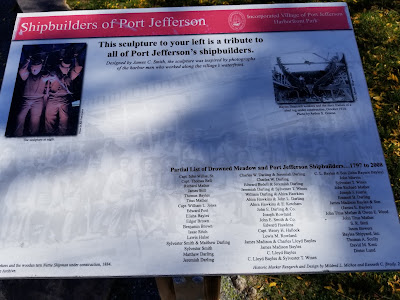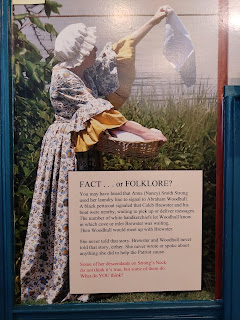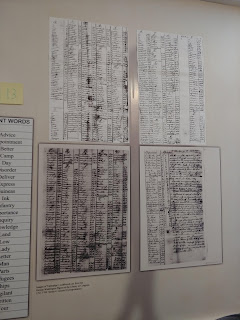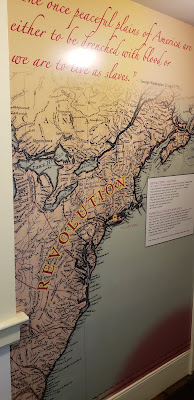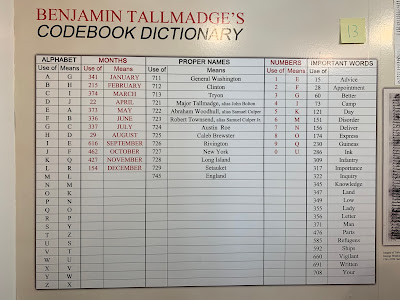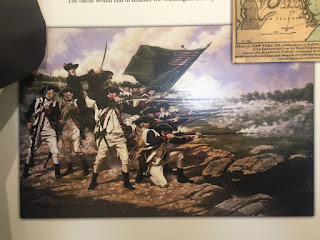Culper Sr. and Culper Jr. – Agents of Intelligence Behind American Revolution
by Joanna Zhu
Abraham Woodhull and Robert Townsend were two important spies that contributed to the success of the American Revolution War. They were part of the Culper Spy Ring with code names Culper Senior and Culper Junior respectively, which was named after George Washington’s birth county, the Culpeper County. Abraham Woodhull was asked by Benjamin Tallmadge, his childhood friend and the chief of intelligence, to become a spy and help Washington gather information on British forces in New York City. Woodhull was the first candidate Tallmadge considered because although Woodhull lived in Setauket, he had a sister who owned a boardinghouse in Manhattan. So, he had a legitimate reason to visit NYC and stay for some time to oversee British activities. Then he would bring the information back to Setauket and relay it to Washington through other spies in the Culper Spy Ring.
Picture 1: Original quote by George Washington to Abraham Woodhull, telling him to travel to NYC and gather intelligence, information from spying, on British soldiers (©three village historical society).
As you can expect, spying on British soldiers and traveling back and forth between NYC and Setauket placed great dangers and pressures on Woodhull. That caused his anxiety to flare up and this was when Robert Townsend started to get involved. Under the influence of his severe anxiety, Woodhull revealed his identity as a spy to Townsend, a man he met at his sister’s boardinghouse. Robert Townsend was a better candidate to gather information on British troops than Woodhull because he was a store owner in Manhattan whose customers were often British soldiers. Also, the British thought him as a loyalist because he wrote columns for another loyalist, James Rivington. As a result, he could listen to the conversations without attracting suspicions of British soldiers; then he would send the message to Woodhull, who now stayed in Setauket, through a courier. Surprisingly they were only in their late 20s when they start working as spy. I cannot imagine the hardships and pressures they were constantly living under, I personally don’t think I can handle such work at that age. These two men, Culper Sr. and Culper Jr., were key agents of the Culper Spy Ring. Although their real names were never disclosed to even Washington himself, they were critical to the ultimate victory of patriots in this war.
Picture 2: A map showing important locations in New York City where spy activities occurred. Including the quote from Washington to Townsend, acknowledging the pass of hand to Culper Jr. from Culper Sr., and ordering him to remain in the city to gather information on British soldiers (©three village historical society)
Port Jefferson and the Ship Builders
by Lucas Wong
After leaving the 3 Villages Historical Society, we traveled to Port Jefferson, a few miles from the museum. Port Jefferson, named in honor of Thomas Jefferson, was once a drowned meadow which flooded regularly. Port Jeff is sheltered and deep that allowed ships to come in and out of the harbor for trade.
The narrow entrance to the Port Jefferson harbor. The harbor is sheltered by sand bars and is deep for ships to pass through, such as the Port Jeff ferry to Connecticut.
The town started off heavily on ship building. Long island had plenty of wood that supplied the ship building industry. This led to a demand for people who can build ships, people that know about carpentry, sewing, blacksmithing, etc. This demand for people developed the Port Jeff town, it became a maritime community that heavily relied on ships and ship building. The community shifted to whaling when the ships were built. This required sailors and people that have knowledge of the sea and the ships. The families that lived in Port Jeff revolved around these people and the people that built the ships. More towns like this started to grow as ship building communities.
The town of Port Jefferson made a sculpture to commemorate the people that started the town and how it started.
With the decline of the whaling industry, Port Jeff struggled to get people to stay and prosper. The town started to decline even more in the 20th century when boats started to be powered by engines and the hulls were being built from metal. The need for carpenters and sail makers diminished and were slowly replaced. This also led to the decline in ship building around Long Island. The town attempted to bring a new industry into their town by bringing a watch making company. That didn’t last long because there wasn’t a high demand for watches. The town also brought a man, PT Barnum who started the Barnum and Bailey Circus. Barnum used Port Jeff as a winter training grounds for the circus but received a lot of criticism because not many people wanted the circus in ton because of its exotic and unusual things. The circus ended up moving its winter training grounds to Connecticut. The town then started selling its quaintness of the town to the upper class. From this, we start to see a flux of people from the city move out to Port Jeff and that’s how we get the Port Jeff we see today.
Blog Post: Setauket, Port Jefferson Harbor
by Sandra Reyes
During our trip to the Three Village Historical Society we learned a lot about George Washington and his succession in creating a spy ring. Although, since everything in the spy ring was so secret there are still many unanswered questions related to how the spies communicated. Due to this, we have only been able to go off folklores that have been passed down families that stretch generations. One of the more famous stories is the one regarding Anna Smith Strong and her hand in helping Caleb Brewster and Abraham Woodhull, spies for Washington.
Anna Smith Strong came from a wealthy family and ended up marrying Cilia Strong at the age of 20. Soon after Anna and her husband settle down in their house on the lake and have six kids the Battle of Long Island happened. Her husband ends up getting arrested, although because Anna had family (the Tories) in the war, she was able to get him released. He felt it unsafe to return since he would be watched so he didn’t and instead of following him Anna stayed in the house with her six kids. The folklore goes that she chose not to follow him because she was a spy for Washington. Her part was one that could also keep her safe, she was simply to put out a black petticoat if she knew Abraham Woodhull was waiting in the cove and then she’d place different color handkerchiefs to identify which cove he was in.
The reason there is little proof of this folktale is said to be because they took extra precautions in the safety of their female spies. Women spies typically were kept out of all letters and weren’t even given a number to be associated with. Benjamin Tallmadge was entrusted to make spying safer and one way in which he did this was to make a codebook dictionary of around 800 words he thought the spies might need in their messages to Washington or each other. Some spies got numbers as part of the code, however, the females typically never did. Another way they tried to keep them safe was by using invisible ink in their letters in case it was taken by the British.
Spies from the City, to Long Island and Upstate
by Jeffrey Kraemer
Picture 1: This map shows an extended view of the colonies at the time of the revolution. Although most of the fighting was done in the New England Colonies and New York, towards the end of the war fighting moved to the south around Virginia and the Carolinas.
Picture 2: This picture showed the route that valuable information traveled on its way to General Washington while he was somewhere in upstate New York. The letters passed through many hands on its way going from spy to currier to another spy and then another currier to end up at the chief intelligence officer for the revolutionary war. This officer would then translate a coded message and send it on its way to Washington.
Picture 3: The letters from the city would be delivered to Setauket, NY and arrive at mark number 2 in this image at Abraham Woodhull’s farm. Each of the other dots signified a important player in the transferring of letters up the ranks.
Spy Techniques of Long Island’s Culper Spy Ring
by Meaghan Sullivan
On November 1, 2019, the Coastal Cultural Experience class visited The Three Village Historical Society’s exhibit on spies on Long Island during the American Revolution. This was a very exciting topic to learn about, especially for the ones from Long Island, because we had no clue about this interesting part of our history. We learned all about the Culper Spy Ring, which was used to transport crucial information about the movement of the British to George Washington, that may have very well caused the Patriots to win the war.
The letters that were passed from courier to courier along the path to Benjamin Tallmadge, the creator of the spy network, and then to Washington, were extremely sensitive. If they were to ever get in the wrong hands, or found out about, it could have ruined the whole operation. For this reason, there were many precautions that were put in place to hide the information within the letters. One strategy they used was creating a codebook. This meant that letters, words, or numbers could be read one way, but then could be translated into something else with a key. An alphabet switch meant having pairs of letters that could be switched to spell out a new word. For example, based on the picture below GEV is translated to CAT. Numbers were also used to mean letters, specific words, or even people’s names or aliases. This meant that a seemingly boring letter from one friend to another could be decoded to hold secrets about war plans. Another tactic that was used was invisible ink. One form of this secretive writing used heat to reveal the letter’s hidden contents. This was proven to not be that great of an idea because that meant that anyone could reveal the writings. Instead of this type of invisible writing, a special solution was accidentally created by a physician and then used as ink, except this could only be revealed with another special solution. The contents of the solution were kept secret, therefore if anyone found a letter, it would be impossible to show message. The message was often written in between lines of the fake letter, so that it could easily be read once revealed.
This museum was a great experience for the class because it showed a side of Long Island and the American Revolution in general that we were not taught about when we were younger. It was amazing to learn about the inner workings of the spy network that occurred right where we go to school today. We even got to write a few secret messages of our own using lemon juice.
Setauket Spy Exhibit at the Three Village Historical Society
by Tessa Reynolds
(Credit to the Three Village Historical Society)
George Washington knew that to win the Revolutionary War the colonies would need information on the British movements. When Washington asked around to find someone willing to spy on the British, the first person to volunteer was Captain Nathan Hale.
Hale went to New York City on July 15th, 1776 and made maps of the city and took notes on the British for General Washington. Hale spent a few days in the city before being captured by Major Robert Rogers, a British soldier who disguised himself as a Patriot. Major Rogers turned Hale over to the British headquarters in Manhattan and Hale was executed the next day.
Hale’s last words were supposedly “I only regret that I have but one life to give for my country”, which is actually a paraphrase from a Greek play. A firsthand account by British Captain Frederick Mackenzie claims that Hale went to his death with composure, stating it was his duty to obey the orders given to him by his commander in chief. This differs from the story passed down of his last words, hinting at how the Revolution was romanticized.
After Nathan Hale’s failure in 1776, Washington did not set up a spy ring based on Long Island until 1778. The new attempt was run by Benjamin Tallmadge, who was close friends with Nathan Hale during their time at Yale. The fate of Hale influenced how Tallmadge managed the spy ring and led to him working to keep his spies safe.
The Battle that almost ended the War
by Maxwell Bazante
The Continental Army led by President and General George Washington fought the first and largest battle in the American Revolution in August 1776 against Major General William Howe. This was about a month after the signing of the Declaration of Independence. The British Army invaded Brooklyn as a strategic attempt to turn the tide of the war. Britain attempted to take over New York and to isolate it from the colonies. A defeat of the Continental Army could have easily forced their entire army into surrender.
During the Battle of Long Island, the Continental Army was severely disadvantaged by the most powerful and best-equipped army in the entire world. There were about 20,000 British soldiers fighting about 10,000 American soldiers. Washington’s men had very little training and ammunition compared to the British. The American army did not even have a standard issue uniform at this time.
After about ten weeks of battle Washington led his men to escape after crossing over the Hudson river and fleeing into Pennsylvania. The British Army were victorious and successful in taking over New York. Washington and his men wouldn’t come back to New York city for the next seven years.
Three Village Historical Society
by Tyler Rodriguez
One of the places we visited on this week;s trip was the Three Village Historical Society in Setauket. We visited the SPIES! exhibit, and this blog post will be about one critical aspect of said exhibit: primary sources. So what exactly are primary sources? Primary sources are documents created at the time period which is being studied by a historian. This can include letters, personal diaries, journals, photographs, and artwork. These sources are critical to historians as they allow for insight into what was happening at a given time period through the eyes of the people who were around during that time period. One must always view primary sources with a critical eye, as they can be biased or inaccurate. It is up to the person analyzing these documents to determine what information is true, useful, and factual.
The vast majority of the SPIES! exhibit utilized primary sources as the information reference. Direct quotes from primary sources such as the one seen above were used heavily in the exhibit. The means of procuring these documents is also worth mentioning, as some documents are in places such as the National Archives. These sources hold significant power, as they are some of the few remaining connections to the time period covered in SPIES!. I as an aspiring historian am particularly interested in primary sources because they provide information that could have otherwise been lost to time. It is also very interesting and fun for me to determine what in the primary sources is relevant and factual, as the lines between fact and fiction can become very blurred through time. SPIES! was an excellent exhibit that exemplified the usefulness of primary sources.
Is Whaling the Right Industry for Your Community?
by Josh Whitehead
For our last field trip, we went to Setauket and Port Jeff, to learn both about the communities during the American Revolution and their role as spies during the British occupation of Long Island, and their culture as a sea faring community. It was a chilly but sunny day which was a welcome break from the past week of being rainy and dreary, excellent weather for a waterfront talk from Tara.
During this Tara explained how Port Jeff came to be as we know it today, and not as it was in the beginning when it was called Drowned Meadows, due to the very swampy land. Named after Thomas Jefferson, Port Jeff was solidified by its inhabitants to become a town. The land once solidified was very productive for them as it allowed them access to Long Island Sound, the harbor for trade and the waterways for fishing, but more importantly whaling. Whaling was a lucrative business and before being commercialized it would be a community ordeal. You would’ve had spotters, often yelling to the men who would go hunt the whale, who would take off immediately in their boats. In near shore whaling these boats would be smaller and would have to be rowed back into shore once they got their whale. Once back the whale would be processed and the men would parade around town showing off the whale bits they have on them from their hunt, apparently this was found to be appealing, to each their own I guess.
Whaling, for Port Jeff was like the car companies for twentieth century America. It was a huge industry that fed more jobs and skills that were all necessary for successful whaling. From whaling you supported jobs like carpentry, blacksmiths, coopers (barrel makers), sail makers, and the sailors themselves. The whale these men were after were called the right whale, a slow-moving large whale with lots of oil. These reasons led it to being named the right whale, as it was the right whale for them to hunt, even in the 1700s there were dad jokes. These whales could fill sixty barrels with oil of which could be sold or used for the village. Whaling made the town boom, but just as with the car manufacturers, when the productivity dried up the town suffered as well. When whaling left Port Jeff, there was a large gap that needed to be filled, which they tried to by bringing in watchmakers that wasn’t very successful.
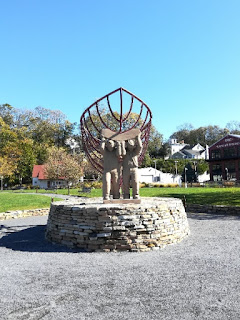 |
|
Port Jeff was also known for shipbuilding, this monument depicts the men who would build the boats that the whalers would use.
|
Port Jeff eventually saw that tourism was going to be the best industry to replace whaling, as they had beautiful waterfront property and natural surroundings. Everything the rich New York City socialites were trying to escape. This movement towards tourism earned Port Jeff and surrounding areas the name “the gold coast”. There are some parallels culturally between the whaling and the tourism that replaced it, mainly in the diverse crowd that both brought in. People from all backgrounds were involved with whaling and the same is true for those who come for the touristic side of Port Jeff.
 |
|
Port Jeff’s water front and access to long island sound makes it a popular summer spot for people to dock their boats.
|
George Washington, MAR355, and SPIES! Oh My
by Kristi Flanigan
When I think of the Revolutionary War, I don’t think about spies, or a young George Washington creating a spy ring. I don’t think about young men wracked with anxiety from the high stakes situations they took part in. I don’t think about the women who might have clandestinely helped by applying a code to the way they hang clothes out to dry. I think about the Boston Tea Party, and about a bunch of wars and battles and dates I had to try memorizing in grade school, as much as I hate to admit it. But that’s the wonderful thing about Coastal Cultural Experience – the class really takes you to places you might not have even realized were nearby where you’re already going to school. This class brings so much culture and history right to your doorstep. It encourages you to rethink what you know, and to really appreciate the significance of the ground you’re standing on. Take George Washington, for example. I, for one, learned so much about him that I wasn’t aware of when we visited the SPIES! exhibit at the Three Villages Historical Society.
It’s easy to picture George Washington as older, with a white wig and wooden teeth. Maybe you’ve paid in cash for something and watched his face silently judge your financial decisions. But he was actually age twenty-three when he said, “there is nothing more necessary than good Intelligence to frustrate a designing enemy, and nothing that requires great pains to obtain.” Not only is 23 quite young to be thinking so strategically, but it is also quite young to have the experience that lead him to that quote — that was knowledge he probably gleaned from the French and Indian War (the quote is from 1755). It was this knowledge that preceded his creation of a spy ring right here on Long Island during the Revolutionary War.
What’s important to keep in mind when revisiting what you know about history (in this case, George Washington) is to sort folklore and mythos from reality. Consider the cherry tree story about George Washington. That never happened – it’s merely a story to commend his character. It’s important to make note of folklore and why it came about, yes, but it’s also unfortunate the it was the cherry tree story taught in grade school, instead of something truthful and inspiring and honest about how young George Washington was when was living a life that would lead to presidency. Not to say that he was a person without flaws, for the record, just that showcasing his actual accomplishments might have left a bigger impression on grade-school me. The SPIES! exhibit did a wonderful, fascinating job of piecing stories together from primary source documents. That’s the takeaway here, I think: learn from the source, and never hesitate to dig deeper. Look around! The stories might surprise you.






